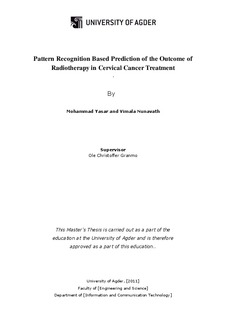Pattern recognition based prediction of the outcome of radiotherapy in cervical cancer treatment
Master thesis
Permanent lenke
http://hdl.handle.net/11250/137533Utgivelsesdato
2011Metadata
Vis full innførselSamlinger
Sammendrag
Cervical Cancer is one the most common cancers amongst women. Ev-
ery year almost 300 Norwegian women are diagnosed with cervical cancer.
It is the 5th most deadly cancer type amongst women in the world. Esti-
mates show that there are approximately 473,000 cases of cervical cancer
in 2008 and 253,500 deaths per year. As we can see from the statistics, cer-
vical cancer is a very severe and common type of cancer which costs many
human lives every year. Therefore any progression in prognostication of
this disease is very essential to treatment of its patients.
Our task in this project was to analyze contrast enhanced MR imaging
data from 78 patients. This data was recorded after a certain period of
time after the patients received radiotherapy. The data was collected
after a median time of 48 months for each patient. The outcome of the
treatment and propagation of the contrast medium in to the blood vessels
(in tumor region) was recorded.
The main focus of this project was to model spatial patterns in the
Cervix Cancer data set using hidden Markov models (HMM) in one of
the machine learning techniques can be used to predict the outcome of
radiotherapy treatment of the cervical cancer patients based on identi ed
patterns with given data samples.
To nd the unobserved (hidden) patterns, we have used hidden Markov
models on the dataset to nd hidden patterns in the data. These models
show the distribution of the outcome of the treatment, grouped by the
similarities between properties of the contrast medium in the blood vessels.
Our research shows that hidden Markov models are not feasible for this
dataset. It was not possible to retrieve any information with high enough
accuracy to be able to predict outcome of radiotherapy treatment.
Beskrivelse
Masteroppgave i informasjons- og kommunikasjonsteknologi IKT590 2011 – Universitetet i Agder, Grimstad
